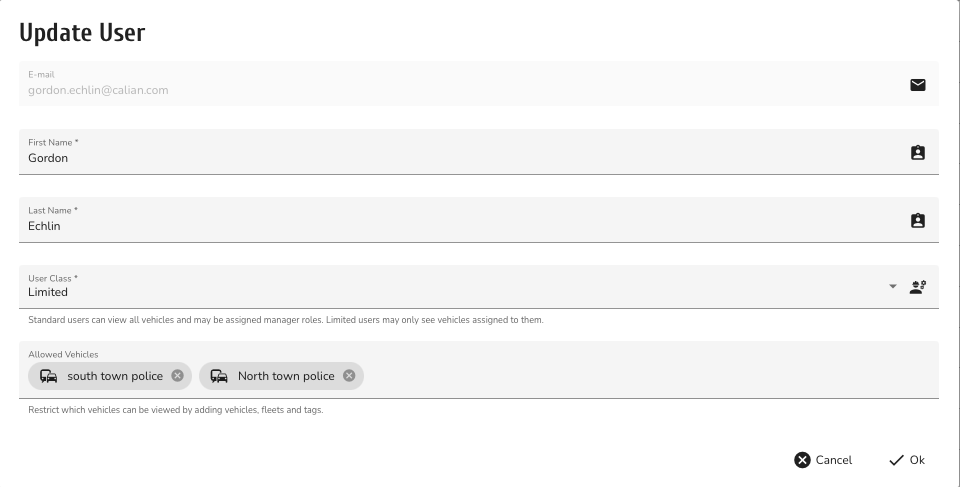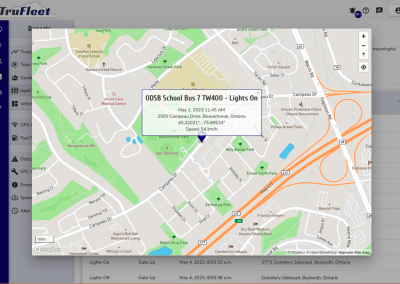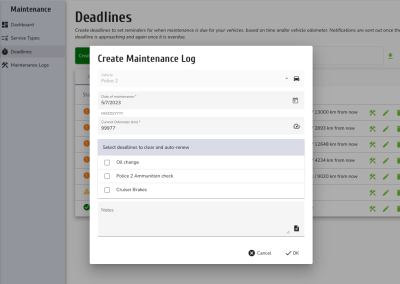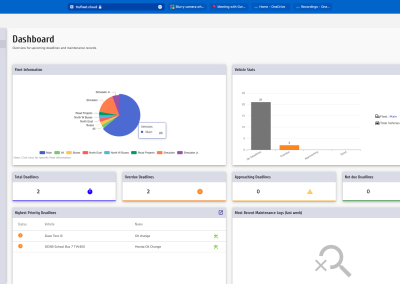Public Safety
Quick and effective Mobile Mission Awareness with TruFleet®
Mobile missions for public security are a complex and dynamic collaboration of multiple systems, assets, actors and stakeholders, with one key focus: Ensure the right team and the right assets are at the right place at the right time. This requires information that is easily understood, managed, visualized, and flexibly interconnected with ALL your systems, current, legacy and future. TruFleet delivers on the promise of accessible and timely location, and gives you the option to extend your focus as far as it needs to go.
- Keep track of Vehicles, Personnel, and On-vehicle Assets
- Audit Historical Performance
- Dashboards
- Comprehensive reports
- Monitor out of hours usage
- Maintenance scheduling
- Use Radio Network or Cellular network for communications
- Clean, intuitive User Interface
- Export Data to 3rd Party Applications
- Email, In-App, System and SMS notifications
- Privilege based user accounts
- Precise positioning in deep urban canyon environments
- Multi-Department Municipal management under one “pane of glass”
- Full mobile device application support
- On-Premises or Cloud-based versions
- Indoor portable tracking in On-Premises WCP Server



Track Vehicles, Personnel and On-Vehicle Assets
Return to IndexTruFleet is designed to give you a real-time and historical perspective on all of your mobile operations.
TruFleet tracks vehicles and key status information using the Sprite TW400 tracker, which can communicate with the vehicle ECU’s and 4 sensor inputs to track vehicle parameters such as siren on/off, lights on/off, trunk open/closed. Vehicles are also tracked by GPS enabled Mobile Radios (Motorola, Tait, Kenwood) over the radio network.
TruFleet tracks personnel via GPS enabled Mobile Radios (Motorola, Tait, Kenwood) over the radio network and/or Blue Tooth enabled tags with the Sprite TW400 tracker
TruFleet track key assets on board your vehicles using Blue Tooth enabled tags reporting to the Sprite TW400 tracker.
Ensure vehicles/devices are being used properly, including behavioural issues such as speeding or out-of-hours usage.
All information is at your fingertips using the clean and intuitive TruFleet user interface.

GeoLocation Tools
TruFleet Mapping
TruFleet has an expansive mapping area which allows multiple different mapping styles to be used, whichever is desired. On this live view, all or a filtered set of devices (radios) or vehicles being tracked can be viewed. Vehicles/devices will change position as they move.
Vehicle/devices can be quickly found. Specific views (map location, zoom level, map type) can be bookmarked. Layers can be toggled on and off.
Map Layers
On top of the basic map, Points of Interest and GeoFences can be added and made visible or invisible. GIS features from ArcGIS servers (priate organization and municipal information shown on the map) can also be imported
Easy Management
The management of your TruFleet Space is achieved via the very prominent left sidebar. From this point you can easily access menus for:
- The live Map View
- Route Replays
- Administration
- Reports
- On-Vehicle Asset Tracking
- Maintenance
From the sidebar, actions specific to a vehicle/device can be executed. This feature is also available when focusing on a vehicle/device icon or marker on the map .
GeoSearch
GeoSearch is a powerful tool that allows you to create a search area, specified by time and filterable to a set of vechicle/devices. A GeoSearch returns the reported vehicles and their time-stamped locations within the search area. Very useful for incident and performance reporting and analysis
Vehicle Status Tools
Telematics
What is the current state of one of the most critical pieces of my mobile mission … the vehicle? The Sprite TW400, embedded in the vehicle, lets you understand in real time, and historically, all the information you want to look at. The TW400 communicates this information via LTE-M cellular, which is a lower cost alternative to ordinary LTE.
Location
The TW400 has a built in GPS antenna. It can also utilize an external antenna or an external Smart Antenna which has great advantages in “deep urban canyon” settings. See Deep Urban Canyon
Diagnostics, Odometer and Fuel Consumption
The TW400 connects to the vehicle CANBUS and uses industry standard protocols (OBDII and J1939) to extract key information about the operational status of the vehicle when available, like the current Odometer reading, any diagnostic trouble code
I/O for detection of important vehicle functions
The TW400 has 4 digital inputs to monitor sensors on such things as doors (Open/Close), Power Take Off (On/Off), Sirens (On/Off), Light Bars (On/Off). There is also an Analog input to monitor such things as refrigerator temperature, and 3 digital outputs to control equipment on the vehicle
Emergency Button
The TW400 can assign an input to special emergency behaviour, which generates specific notifications and visual cues in TruFleet
Behaviour
A built-in accelerometer can be used to monitor driver behavior, such as acceleration and braking
Never miss data when in poor communication areas
Onboard memory preserves trip information when the vehicle is outside of communications range
Easy Information access and Configuration in Trufleet
Whatever you are monitoring, TruFleet lets you quickly name it for your reporting and easy recognition. Naming I/O monitoring can be broadly applied or specific to a single vehicle
Telematics
What is the current state of one of the most critical pieces of my mobile mission … the vehicle? The Sprite TW400, embedded in the vehicle, lets you understand in real time, and historically, all the information you want to look at. The TW400 communicates this information via LTE-M cellular, which is a lower cost alternative to ordinary LTE.
Location
The TW400 has a built in GPS antenna. It can also utilize an external antenna or an external Smart Antenna which has great advantages in “deep urban canyon” settings
Diagnostics, Odometer and Fuel Consumption
The TW400 connects to the vehicle CANBUS and uses industry standard protocols (OBDII and J1939) to extract key information about the operational status of the vehicle when available, like the current Odometer reading, any diagnostic trouble code
I/O for detection of important vehicle functions
The TW400 has 4 digital inputs to monitor sensors on such things as doors (Open/Close), Power Take Off (On/Off), Sirens (On/Off), Light Bars (On/Off). There is also an Analog input to monitor such things as refrigerator temperature, and 3 digital outputs to control equipment on the vehicle
Emergency Button
The TW400 can assign an input to special emergency behaviour, which generates specific notifications and visual cues in TruFleet
Behaviour
A built-in accelerometer can be used to monitor driver behavior, such as acceleration and braking
Never miss data when in poor communication areas
Onboard memory preserves trip information when the vehicle is outside of communications range
Easy Information access and Configuration in Trufleet
Whatever you are monitoring, TruFleet lets you quickly name it for your reporting and easy recognition. Naming I/O monitoring can be broadly applied or specific to a single vehicle
Audit Historical Performance
Return to IndexTruFleet has a broad array of reports for tracking the key parameters of your mobile mission teams, from detailed and informative visual reports on vehicle/device movements using route replays, to the location history (location and the vehicle it was on) of a specific asset, such as a firearm or defibrillator, or the maintenance history of a particular device/vehicle. Each report can be downloaded as a CSV file. TALLYMATICS also is very responsive to new report development. There are also 2 Dashboards, 1 for the system in general and the other for maintenance. Some of the prominent reports
- Route Replay
- Fuel Consumption
- Timeline
- Geofence
- Input Report
- Vehicle Dashboard
- After Hours
- Speeding
- Emergency History
- DTC History


Effective Route Replay for Trip Analysis
TruFleet.Cloud parses all vehicle/device movement into trips, with associated events such as I/O status, asset acquisition and emergencies plainly grouped with the trip. Events can be jumped to from the Trip index in the left sidebar, and replays can be generated from the sidebar, a vehicle/device marker dialog box in the live map, and Timeline Reports.
Timeline Reports – Fleet activity at a glance
TruFleet.Cloud parses all vehicle/device movement into trips, with associated events such as I/O status, asset acquisition and emergencies plainly grouped with the trip. Events can be jumped to from the Trip index in the left sidebar, and replays can be generated from the sidebar, a vehicle/device marker dialog box in the live map, and Timeline Reports.
Input/Output: Rapid and precise detail recall and mapping
Quickly filter events such as siren on/off on a per vehicle (or filtered by any group or fleet), then pick an event and map the location. A good feature for quickly analyzing activity around a reported incident
Vehicle Dashboards
For a quick snapshot of what is going on with a vehicle/device or driver, the vehicle dashboard has several elements relating to the most recent 2 weeks.
- Device Info: Identifying the name, type, ESN/ID, I/O and services enabled on a device
- Immediate Status: Online/offline status, Diagnostic Trouble codes, missing assets, emergency status
- last known location
- Average and top speed
- odometer (past 2 weeks and lifetime)
- The timeline report for the vehicle for the past week
- The event records (all notification eligible events)
After Hours Reporting
Return to Index- Define non-contiguous out of hour periods
- Different every day
- Different to the individual vehicle level
A major issue for managing vehicles is the illicit use of them for personal purposes, however there is rarely a one size fits all solution. Different drivers and vehicles have different periods of time when they are being used for legitimate work or duties. In fact, that may change every day, and eligible usage times may not even be a contiguous period. TruFleet.Cloud allows for each vehicle/device to define a different set of eligible use periods during each day (24 hours) of a week.

- Define maintenance rules for vehicles or assets on vehicles
- trigger by odometer or time
- Assign rules to vehicles by deadline
- Customize on a per deadline basis
- log maintenance
Maintenance is not about “canned” programs based on manufacturer vehicle specifications. Maintenance changes based on expected usage and actual usage. It is also something that can be applied to vehicle payloads, checking everything from first aid kit refills to ammunition payloads. TruFleet.Cloud takes a flexible rule definition and deadline approach to rule creation and application, with a nice flexible log that allows you to select the deadlines you wish to act on at the moment.
If there is an observation to be be made, you can make it inline on the log at the time of closing the deadline … or after if you wish.
Due deadlines are visible in the vehicle sidebar using a visual cue, and can be immediately accessed for action.
Maintenance Dashboard
Since you don’t react, but plan, the maintenance dashboard gives you a great view of your fleets, the deadline status, and prioritizes action based on the most pressing deadlines. You can quickly drill down into each part of the fleet from the pie-chart
Multi-Network, Multi-Device, Multi-Vendor
Return to Index- Track cellular based telematics devices: TW400
- Track Radio network devices:
- Mobile Radios
- Portable Radios,
- Telematics for radio,
- Push to Talk over Cellular
- Tait
- Kenwood
- ICOM
- Motorola
Mission awareness for Public Safety needs redundancy and flexibility. That means using all communications means available to you. TruFleet goes beyond the typical cellular based tracking to track across your radio networks … multiple vendors and types … and can do that in concert with cellular based telematics devices. This gives you the flexibility to utilize every network at your option.

Data Export/Import
Return to Index- Export Location information and Event information
- Export in various formats
- Real-time XML – Multi-Speak
- Scheculed CSV for International Fuel Tax
- Real-Time Full event set over JSON
- Every Report in CSV format
- Import vehicles, points of interest, geo-fences in CSV format
In a complex operating environment that multiple management applications, from Enterprise Resource Planning, to Real-Time Situational Analysis, to vehicle life-cycle management, to municipal scheduling/utilization platforms, you need to be able to export all the data in TruFleet to this systems easily. Alternatively, you have legacy information that you want to use in your geo-location platform, such as geo-fences outlining specific parts of the urban landscape. TruFleet multiple ways to export this data to your other systems, at the same time using TruFleet’s toolsets for quick and effective focus on mission status in all its dimensions.

Notifications
Return to Index- User account configurable
- Notify on multiple events
- GeoFence,
- Emergency,
- Speeding,
- Diagnostic Trouble Code,
- Asset left behind,
- After Hours,
- Maintenance Deadline passed
- Multiple notification methods:
- In-App notifications,
- Email,
- SMS,
- Push (system),
- filtered by fleet, tag or vehicle
Account Privileges and Restricted Accounts
Return to IndexThere are several level of user accounts:
- Owner
- Standard
- Limited
Owner accounts, which are recommended to be few in number, have the privilege to do anything. No privilege can be taken from them. They have visibility of all managed items.
Fully privileged Standard accounts can do everything that an Owner account can do, but on creation which permissions they have are specified. The permissions are:
- Manage Groups (Fleets/tags)
- Manage Users
- Manage Vehicles/devices
- Manage the system
- rules,
- geofences,
- maintenance rules and deadlines,
- Points of Interest
- Export servers
- I/O definitions
- Manage Assets
Standard Accouns can still see all vehicles.
Limited accounts have NO management privileges and are limited in their visibility of vehicles/devices according to a filter specified on creation, which is specified by allowed fleets, or allowed tag groupings or allowed individual devices and vehicles

Standard Account privileges

Limited Account Visibility
Deep Urban Canyon operation
Return to IndexAn important consideration in public safety telematics, and in fact any public fleet, is that Global Navigation Satellite System locations are in fact … not as accurate as one might think. They are greatly affected by the quality of the antenna, and once you start to see multi-path interference … the error grows dramatically. Multi-path interference is interference caused by the reflections of the satellite signals bouncing off of buildings, which causes great error on the screen amongst many buildings in a city … the Deep Urban Canyon.
If accuracy is required to ensure that the information is auditable, e.g. in the scenario where there is potential liability for an accident, then using the Sprite TW400 with an external TALLYMATICS TW5362 Smart Antenna with embedded Inertial Management Unit is the way to go. This device calculates a location decision using the combination of satellite GNSS and Untethered Dead Reckoning via the built-in IMU. The figure at the right shows 2 different geo-location solutions in a deep urban canyon, a competitors product and the TW400 product. Both show multiple circuits of the route, and 1 second interval sampling. The evidence speaks for itself.

Comparison of Geolocation with and without Untethered Dead Reckoning
Multi-Departmental Collaboration
Return to Index- Department/task orientation deep focus
- Tags for sub-fleet grouping
- infinite sub-fleets
- selected data export on filtered vehicle/device set
- Cross department visibility
A municipality, or even a standard fleet, is composed of different departments with different objectives, operations and management e.g. road maintenance vs. the police department vs the fire department. On the other hand, especially in public safety, there are times when everybody (Police, EMS, Fire) needs to be on the same literal page, and fast.
TruFleet.Cloud provides management tools (visibility on flexible filtering using sub-fleets and/or tags, filtered data export and feature visibility) that allow multiple departments to use the same TruFleet Organization as if they were operating on their own, while maintaining the ability to view all fleet information when required.






















